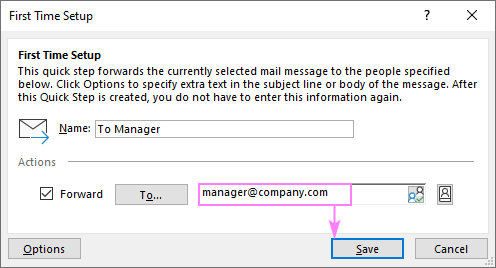

Select Customize Ribbon in the left pane.Click the File tab and then click Options under Help in the left pane.With the macro in place, add a custom group to the Ribbon as follows:
#OUTLOOK QUICK STEPS NOT LOADING UPDATE#
Update the Set myItem statement to reflect the name of your template but keep the IPM.Form component (that’s the class). Set myFolder = Session.GetDefaultFolder(olFolderInbox) The first thing you need is a macro use the following sub procedure as a guide: Sub OpenCustomTemplate() If you have several templates, add a custom group to the Ribbon for easy access. At this point, you can fill in any remaining information before sending. To use the Quick Step message as a template, select it from the options in the Quick Steps group - selecting it will open the generic message.

In addition, a message in the Drafts folder is easy to delete. You’ll save a few steps, but this tip works best with limited messages. (If you send it as usual, Outlook will delete the message from the Drafts folder.) Then, double-click the message in the Drafts folder, complete it, and click Forward to send it. Another option is to save your basic message in the Drafts folder. Opening a template, while more efficient than re-creating the message, takes several steps. Make the necessary changes to update the message and click Send as you normally would.Double-click the template or select it and click Open.From the Look In drop-down, select User Templates In File System.In Outlook 2007, select Choose Form from the New option’s drop-down. In the Mail window, click the Home tab, choose More Items from the New Items drop-down in the New group, and then select Choose Forms from the resulting submenu.To use an existing template, do the following: Click Save and Outlook will save the template file to the default folder.From the Save As Type drop-down, choose Outlook Template (*.oft).Click the File tab or the Office button.Add the text and apply styles and formatting.Creating template files for reuse is an easy process:

Message templates let you create and store information you send regularly. These tips will help you put templates to work for you. You’ll save time and reduce potential input errors.

Create a template and base new messages on it. If you send the same information or use the same styles and formatting repeatedly, don’t re-create the effort every time you send an email. You can save a lot of time and effort if you use templates in Outlook - and you can save even more time and effort if you put these template techniques to work. On July 22, 2011, 6:05 AM PDT 10 timesaving tricks for working with Outlook message templates


 0 kommentar(er)
0 kommentar(er)
